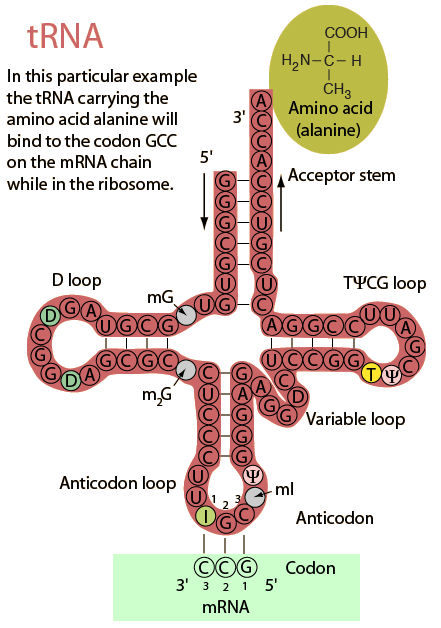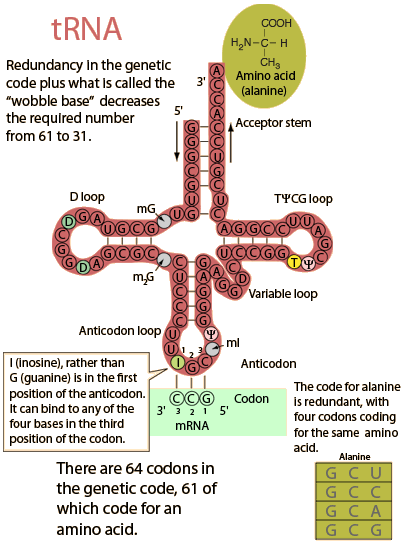Transfer RNA
The ribonucleic acid (RNA) that is directly engaged in the translation of the sequence of nucleotides in messenger RNA to amino acid sequences for the construction of proteins is called transfer RNA or commonly tRNA. The manufacture of the tRNA itself is directed by the DNA in the cell that provides a pattern for the production of RNA by "transcription".
Below is an illustration of the composition of an example of tRNA in what is commonly called its cloverleaf form. It is a two-dimensional projection of the form of the molecule. It's actual three-dimensional shape is more complex, but this is a common way to depict it to emphasize its function of binding an amino acid to one end corresponding to the anticodon on the opposite end. This anticodon will bind to a codon consisting of three nitrogenous bases which specify an amino acid according to the genetic code. This illustration is patterned after an example in Rana. This tRNA was investigated in yeast and its structure was the culmination of seven years of work by Robert Holley of Cornell University.

When the messenger RNA blueprint for a protein reaches a ribosome for the process of building a protein by translation of that blueprint, tRNA molecules with all the required amino acids must be present for the process to proceed. Since most proteins use all twenty amino acids, all must be available, attached to appropriate tRNA molecules. In this example, the tRNA has bonded to the codon GCC on the mRNA, GCC being one of the codons corresponding to alanine. This leads to the placement of alanine in the proper place in the growing polypeptide chain that is to become a protein.
| The many forms of tRNA have roughly the same size and shape, varying from about 73 to 93 nucleotides. Besides the usual bases A, U, G, and C, all have a significant number of modified bases, which are thought to have been formed by modification after the transcription. Some of those modifications are listed in the table. All tRNAs have sequences of nucleotides that are complementary to other parts of the molecule and base-pair to form the five arms of the tRNA. Four of the arms are fairly consistent, but the variable arm can range from 4 to 21 nucleotides. |
References:
Wiki tRNA
| How many distinct tRNAs are required? |
| How are the amino acids correctly assigned to tRNA molecules? |
Biochemical concepts
Chemistry concepts
References:
Rana
Karp
Sec 11.7
| HyperPhysics*****Chemistry *****Biology | R Nave |
